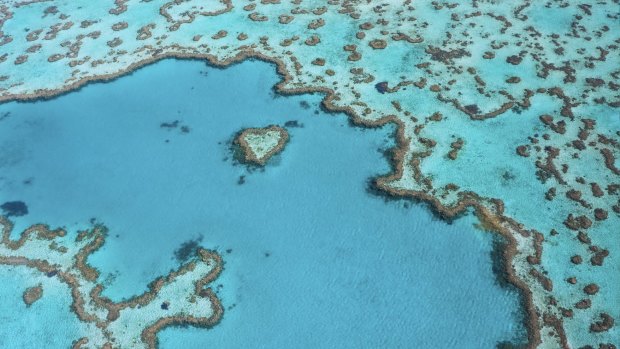This was published 2 years ago
Great Barrier Reef's UNESCO World Heritage status still under threat
By Lee Tulloch

National treasure: the Great Barrier Reef.Credit: iStock
In mid-July Federal Environment Minister Sussan Ley jetted away on an urgent mission to more than a dozen countries to lobby members of UNESCO's World Heritage Committee to keep the Great Barrier Reef off its endangered list.
The committee warned Australia that three mass coral bleaching events in five years threatened the very qualities that had won the reef a place on the coveted heritage list in 1981- its astounding biodiversity and unique status as the world's largest living coral ecosystem. The reef was now earmarked for attention on a draft "in danger" list, along with 51 other threatened sites, including the tropical rainforest of Sumatra, Timbuktu in Mali and the Everglades National Park in the US.
For some of us the lobbying was confusing. The purpose of the in-danger list is to highlight World Heritage properties that are in trouble, identify the causes of their decline and address them, in many cases with extra funding.
So, isn't the Great Barrier Reef actually in danger? Why would the Australian and Queensland governments be so hellbent on denying reality? After all, the draft listing was based on the Great Barrier Reef Marine Authority's own Outlook Report 2019. "The report finds the greatest threat to the reef is still climate change. The other main threats are associated with coastal development, land-based run-off, and direct human use (such as illegal fishing)."
Scientists were scathing of the mission. "A triumph of politics over science," says Professor Terry Hughes of the Australian Research Council Centre for Excellence of Coral Reef Studies. "A flagrant breach of public trust and an abandonment of future generations," according to David Ritter, CEO of Greenpeace Australia Pacific.
Much of the government's consternation over being delisted lies in the prestige of UNESCO's World Heritage list and its value as a driver of tourism. It was created in 1978 to name and preserve sites of "Outstanding Universal Value" - specifically, those with cultural and or natural significance that is so exceptional "as to transcend national boundaries and to be of common importance for present and future generations of all humanity."
Drawn from 194 member nations that ratified the World Heritage Convention, a committee considers nominated sites based on one of 10 criteria. The sites are then independently valued by two advisory bodies. The process of getting something listed is rigorous and can take decades.
There are 1129 properties on the World Heritage List, including the Sydney Opera House, which is the youngest, and the Rock Hewn Churches of Ethiopia, which are among the oldest. Among the newest listings is the Trans-Iranian Railroad.
Like many travellers, I'm drawn to the list as a guarantee that a place is significant and well-preserved. Some of my favourites are the historic part of Valparaiso, Chile; the village of Visby on the island of Gotland in the Baltic, and Galle Fort in Sri Lanka, the beautifully preserved Dutch/Portuguese fortress, which might have otherwise been laid waste by the rampant development seen elsewhere in the country.
The "catch", if you can call it that, is this - protection, good stewardship, authenticity and the integrity of properties must be maintained, so countries are on notice. Delisted just last month was the Maritime Mercantile docklands of Liverpool, which have been corrupted by new development.
Australia is justifiably proud of its 19 sites, but there are more storms brewing. Former NSW Premier Bob Carr has written to UNESCO, requesting it send a mission to examine the status of the Blue Mountains heritage area, claiming it is threatened by the proposed heightening of the Warragamba Dam. Watch this space.
There's no doubt the Great Barrier Reef makes an enormous contribution to Australian tourism, valued by Deloitte Access Economics at $6.4 billion per annum, with 64,000 jobs supported. Recognising the importance of a healthy reef, the Queensland and Federal governments have made a $3 billion investment in the implementation of a Reef 2050 Plan to build its resilience. Along with the establishment of the Reef Trust Partnership by the Turnbull government in 2018, you can't say money isn't being thrown at the problem.
But that may not be enough.
The environment minister argued this time that the warming of the oceans is a global problem which should not be applied to Australia's stewardship of the reef. In other words, the bigger picture is not our fault. Climate activists argue this is disingenuous, that while Australia remains recalcitrant in setting climate targets and continues to be among the world's leading exporters and consumer of fossil fuels, the root cause of the corals dying will not be addressed.
In the end Sussan Ley won a reprieve of sorts for the reef. The committee amended the draft and agreed to keep monitoring the situation, with a further decision pushed forward into February 2022. The caveat was that the Australian government needed to show "significant global action to address climate change" which was deemed critical to slowing the deterioration of the reef's ecosystem.
We'll get back to you on that.
Sign up for the Traveller Deals newsletter
Get exclusive travel deals delivered straight to your inbox. Sign up now.